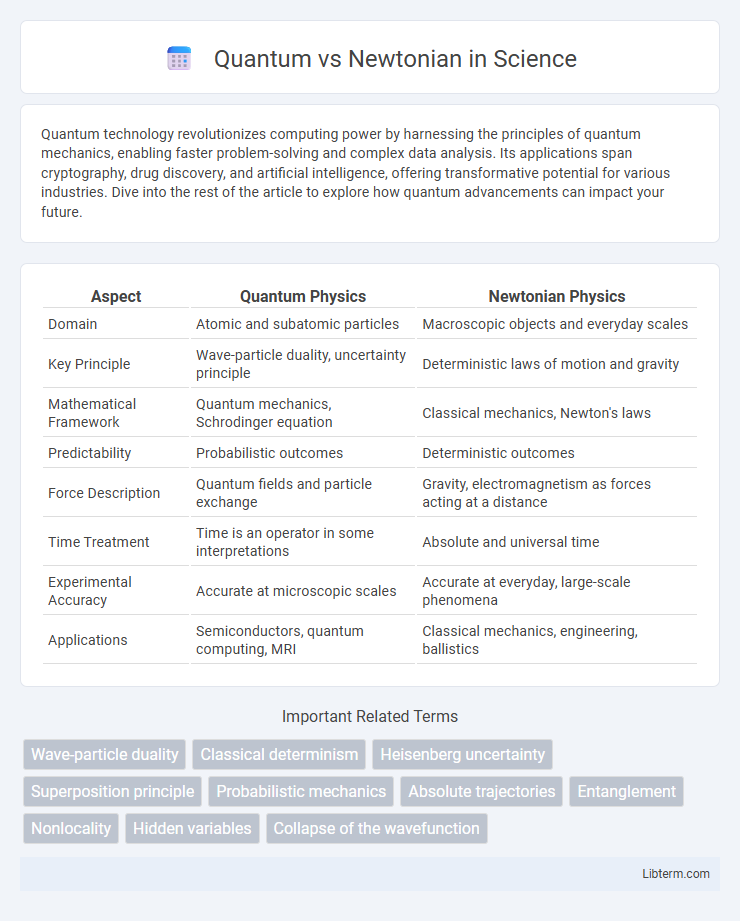Quantum technology revolutionizes computing power by harnessing the principles of quantum mechanics, enabling faster problem-solving and complex data analysis. Its applications span cryptography, drug discovery, and artificial intelligence, offering transformative potential for various industries. Dive into the rest of the article to explore how quantum advancements can impact your future.
Table of Comparison
| Aspect | Quantum Physics | Newtonian Physics |
|---|---|---|
| Domain | Atomic and subatomic particles | Macroscopic objects and everyday scales |
| Key Principle | Wave-particle duality, uncertainty principle | Deterministic laws of motion and gravity |
| Mathematical Framework | Quantum mechanics, Schrodinger equation | Classical mechanics, Newton's laws |
| Predictability | Probabilistic outcomes | Deterministic outcomes |
| Force Description | Quantum fields and particle exchange | Gravity, electromagnetism as forces acting at a distance |
| Time Treatment | Time is an operator in some interpretations | Absolute and universal time |
| Experimental Accuracy | Accurate at microscopic scales | Accurate at everyday, large-scale phenomena |
| Applications | Semiconductors, quantum computing, MRI | Classical mechanics, engineering, ballistics |
Introduction to Quantum and Newtonian Physics
Quantum physics explores the behavior of matter and energy at the smallest scales, where particles exhibit wave-particle duality and uncertainty principles govern their interactions. Newtonian physics, or classical mechanics, describes the motion of macroscopic objects using deterministic laws formulated by Isaac Newton, such as his three laws of motion and universal gravitation. While Newtonian physics successfully explains everyday phenomena, quantum physics provides a fundamental framework for understanding atomic and subatomic processes that classical mechanics cannot accurately predict.
Historical Foundations of Newtonian Mechanics
Newtonian mechanics, developed in the 17th century by Sir Isaac Newton, established the foundation for classical physics through laws of motion and universal gravitation. These principles accurately described the behavior of macroscopic objects and laid the groundwork for centuries of scientific progress. Unlike quantum mechanics, which emerged in the 20th century to explain atomic and subatomic phenomena, Newtonian mechanics assumes determinism and continuity in physical systems.
Emergence of Quantum Theory
Quantum theory emerged in the early 20th century as a revolutionary framework, addressing limitations in Newtonian mechanics at atomic and subatomic scales. It introduced concepts like wave-particle duality and quantization of energy, fundamentally challenging classical assumptions of determinism and continuity. This paradigm shift enabled accurate descriptions of phenomena such as electron orbitals and blackbody radiation, laying the foundation for modern quantum mechanics.
Key Principles: Newtonian vs Quantum Frameworks
Newtonian physics relies on deterministic laws and classical mechanics, where objects follow predictable trajectories governed by forces such as gravity and electromagnetism. Quantum frameworks operate on principles of probability, wave-particle duality, and uncertainty, describing particles through wave functions and non-deterministic outcomes. Key distinctions include the Newtonian assumption of absolute time and space versus the quantum reliance on superposition and entanglement phenomena.
Differences in Describing Motion and Forces
Quantum mechanics describes motion and forces through probabilistic wave functions and quantized energy states, contrasting with Newtonian mechanics, which relies on deterministic trajectories and continuous force interactions. While Newtonian physics effectively models macroscopic objects with defined positions and velocities, quantum theory governs the atomic and subatomic scale where particles exhibit wave-particle duality and uncertainty principles. These fundamental differences highlight the shift from classical determinism to quantum probability in explaining physical phenomena.
Determinism vs Probability: Contrasting Approaches
Quantum mechanics embraces probability, describing particles with wavefunctions that yield likelihoods rather than certainties, contrasting sharply with Newtonian physics, which operates under strict determinism where future states can be precisely predicted from initial conditions. In quantum systems, inherent uncertainty principles limit exact knowledge, making outcomes fundamentally probabilistic. Newtonian mechanics models macroscopic phenomena with predictable cause-and-effect relationships, reflecting a deterministic universe governed by fixed laws.
Applications in the Real World
Quantum mechanics governs the behavior of particles at atomic and subatomic scales, enabling applications in quantum computing, cryptography, and advanced materials. Newtonian physics applies to macroscopic objects and everyday phenomena, forming the basis for engineering, classical mechanics, and aerospace technology. Quantum technology drives innovations such as quantum sensors and quantum communication networks, while Newtonian principles underpin the design of vehicles, infrastructure, and mechanical systems.
Limitations of Newtonian and Quantum Models
Newtonian mechanics fails to accurately describe phenomena at atomic and subatomic scales, where quantum effects dominate, leading to significant discrepancies in predictions of particle behavior. Quantum models, while highly precise for microscopic systems, face limitations in explaining macroscopic phenomena and become computationally intensive when applied to large-scale objects. Both frameworks are complementary, as Newtonian mechanics effectively governs everyday classical systems but cannot account for wave-particle duality, entanglement, and superposition inherent in quantum theory.
Bridging Classical and Quantum Realms
Quantum mechanics and Newtonian physics represent distinct frameworks for understanding physical phenomena, with classical mechanics governing macroscopic systems and quantum theory describing behavior at atomic and subatomic scales. Bridging these realms involves exploring quantum-classical correspondence principles, semiclassical approximations, and decoherence mechanisms that reconcile deterministic classical trajectories with probabilistic quantum states. Research on quantum-to-classical transitions enhances technological advancements in quantum computing and nanotechnology by integrating foundational classical concepts with quantum principles.
Future Perspectives in Physics
Quantum physics is expected to revolutionize future technological advancements through quantum computing, cryptography, and teleportation, offering unprecedented processing power and security. Newtonian mechanics continues to provide essential frameworks for classical engineering and astrophysics, ensuring accurate predictions in macroscopic systems. Emerging research aims to unify quantum mechanics and Newtonian physics under a comprehensive theory, potentially unlocking new insights into the fabric of spacetime and fundamental forces.
Quantum Infographic

 libterm.com
libterm.com